Lessons Learned from 15 Years of Successful Elk Hunting
-
15078
-
0
By John Dudley
For 15 years now, I’ve been a Midwestern bowhunter who plans a trip or two each year to chase elk out in the Western states or in Canada.
There’s no doubt a screaming bull is a whole new level of awesome compared to a strutting turkey or rutting whitetail. You have the body size and massive antlers that take more than one arm to hold up. You have the rutting action that compares to peak whitetail season.
But best of all, you sometimes get to be the hunted because bull elk can respond aggressively to a call.
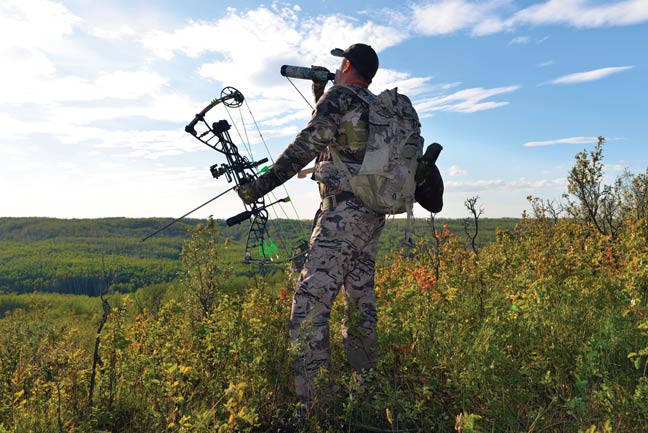
Yep, elk hunting is the bomb, and I’ve been very fortunate to fill more than my share of tags over the past decade and a half. Here, I’m going to share some of the tactics that helped me be super successful in the hope they can do the same for you.
Gear Up
Several years ago, I almost made a mistake that could have cost me a mega bull. I was gearing up for a Montana hunt but also had a few antelope tags I was trying to combine with my road trip.
I made the comment to my friend Randy Ulmer that I was going to choose a lighter, faster arrow for elk that year because I already had my bow dialed in for speed goats and early-season whitetails. Randy quickly shed doubt on my gear choice and urged me to take a heavier arrow.
He was adamant about having extra momentum from a heavier arrow, just in case the shot wasn’t perfectly placed. Needless to say, a few weeks later I had a bull of a lifetime come in, and Randy was right!
As this bull approached, my nerves were redlining. To make matters more complicated, there was a stiff breeze blowing and the bull took a step toward one of his cows just as I released my arrow. It was one of those complicated scenarios that happen in an instant.
I saw the arrow go directly into a rib, right in line with the liver. The shot was further back than I wanted, but the loud crack assured me I had broken the rib. The bull ran off with about half of my arrow sticking out. It was a lethal shot, and I recovered my bull. However, I was grateful I had the heavier arrow, because if I had a lighter one I’m not so sure I would have had the same result.
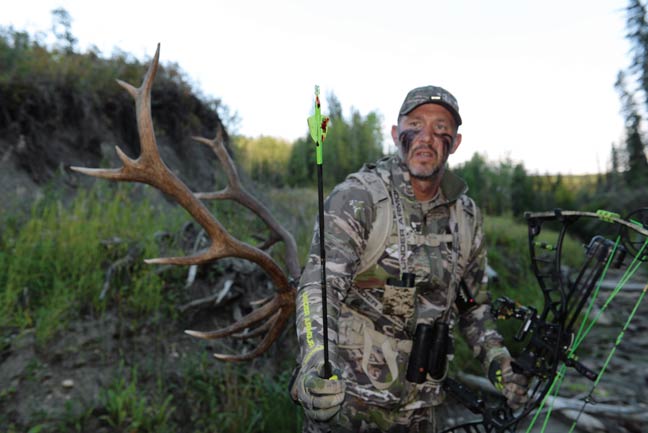
If you are a deer hunting with an elk hunt on your calendar, you may need to boost your penetration for larger game with increased arrow weight, draw weight and broadhead choice. It is my opinion that arrow speed is valuable only when you are shooting a shaft with adequate weight for the game you are after. For elk, I recommend a finished arrow weight of 420 grains as a minimum for hunters drawing 60-70 pounds.
Although bows are becoming more efficient and lower-poundage bows are capable of taking down big game, higher poundage will certainly help you on large game animals. However, it will only help if you can control the pulling weight. If you can’t hold proper form or struggle to pull heavier weight, then lower it to what you can manage. I have had times where I had elk and moose hunts scheduled close together so I chose a bow with a 70-80-pound draw weight simply because I could handle that weight. I combined that bow with arrows that weighed more than 520 grains. It was a devastating setup that pulverized any bone in its way.
In addition to arrow weight and draw weight, the broadhead you choose plays a huge role in determining your penetration.
The big decision is to choose between fixed-blade and mechanical heads. I have shot close to two dozen bulls with my bow. About half were killed with fixed blades, and the other half with mechanical broadheads. Certain heads penetrated better than others, and certain designs flew more accurately than others.
For me, accuracy is the biggest factor. If I can shoot a fixed-blade design as accurately as a mechanical, then it is a coin toss and I may choose a fixed blade over a jackknife-style mechanical. The newer, rear-deploying mechanicals offer much more penetration than earlier designs. My recommendation is to choose a broadhead that groups dependably and has a proven track record for great penetration.
Know When to Run
Another valuable lesson I learned is when to be aggressive. In many ways, elk are like turkeys. They can be extremely vocal at times, and when they are fired up, you need to take control. On many occasions, I made a hunt end in my favor by being aggressive on my feet and closing the gap while a bull was talking.
Like turkeys, elk may chose to be vocal for a brief period but then lose interest. They may also choose to come only halfway to you and then lock up, with no intention of closing the gap.
It’s been my experience that when it is hot, you better strike with intensity and efficiency. I like to move quickly to close as much of the gap as possible without letting the elk see me. Keep in mind elk are big animals, and they are often noisy.
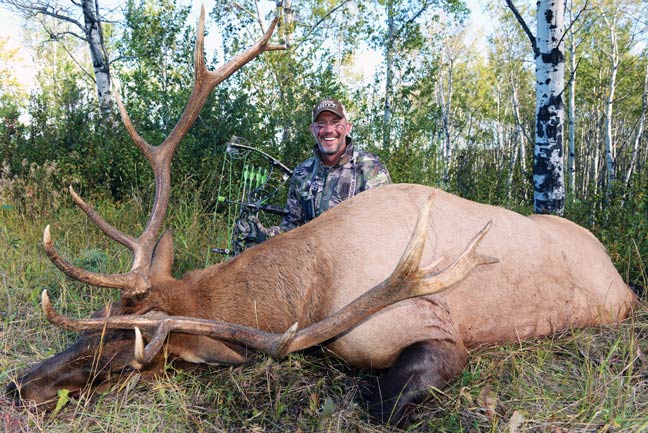
The same should go for you! Being aggressive on an elk means you will likely need to make some noise. Don’t get sloppy with noise, and avoid any unnatural sounds such as metallic clangs and tearing Velcro. However, noises such as sticks snapping, shale sliding or pinecones crunching are OK.
Early in my elk-hunting career, I made the mistake of trying to be too stealthy on bulls I had worked up with my calling. But as I hunted more, I learned to get after it when they were talking back. Cover ground fast, close that gap in half and get into position for a shot. It works well for turkeys, and it certainly has worked well for me on elk too!
Mid-day Death
Last fall, I elk hunted as hard as I ever have. I covered miles and miles only to come across more wolf sign than elk sign. I was dumbfounded that I was not hearing any elk at all. Even at night when I was sleeping in my camper, I never heard a single bugle.
The wolves obviously had completely changed the elk behavior in this area. Many times, I would start to question whether there were even elk around, but then I would come across fresh elk sign. As a last resort, I started covering a lot of bedding areas during the middle of the day.
This tactic was the polar opposite of what I mentioned in the paragraphs before. Since the elk weren’t talking at all, I focused on still-hunting. I would move very slowly through areas I assumed would hold elk and randomly cow call and sit still for 30 minutes or so. Then I would move about 100 yards very cautiously and cow call a few more times.
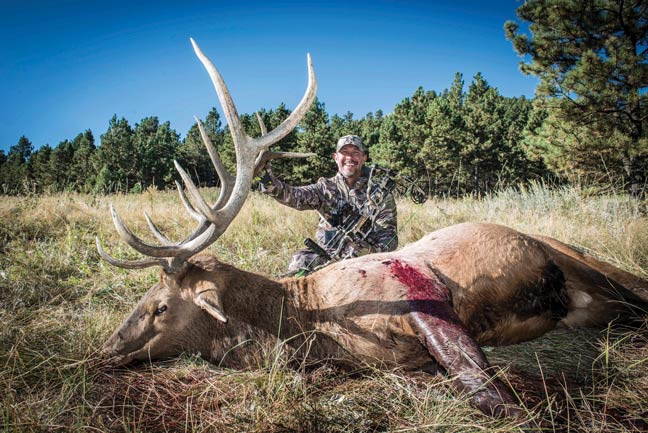
On the second day of trying this, I had a bull bugle back to me from about 60 yards away. He was very close and remained in his bed. I didn’t want to rush it since I couldn’t see the bull. So, I waited about 20 minutes and called again. A few of the cows and calves responded quietly, and then the bull whistled faintly.
It was obvious I had still-hunted right into a bedded herd. The wind direction was good, so I just stayed there quietly and waited for evening to approach. With about 30 minutes of light left, elk started to stand up in this thick timber. The bull immediately bugled one time, and I gave him a hot cow call. He came in to give me a perfect shot. These midday still hunts can be so deadly if you are willing to do them patiently.
Full Frontal
This next topic is certain to get some of you talking. Many years ago, I was deep in the wilderness of New Mexico. My guide and I had been in the hills chasing elk for almost a week, and on many occasions, he had called elk in super close. At first light on this particular morning, he called a bull to about 10 yards but I wasn’t comfortable with the shot angle. The elk lost interest and walked away.
My guide, who was a veteran elk hunter, then asked me, “Can you NOT see the bulls when they are coming in?”
“Yes, I can see them fine but they are always facing me,” I replied.
Then he responded, “If they are that close and perfectly head-on, take the frontal shot!”
My eyes got about as big as many of yours are right now, and I said, “WHAT? That’s a terrible shot!” The guide then went on to convince me that when hunting on the ground, perfectly level with an elk, that the frontal shot is a fine shot to make at a close distance.
He went in depth with telling me about all the arteries that converge in the front of the heart, which sits fairly close to the front of the chest. He went on to explain that there is a large hole in the front of the sternum that any arrow can easily pass with maximum penetration. He then explained that the convergence of the heart, its major arteries and the windpipe is almost the size of a volleyball or pie plate.
“Can you hit that at 10 yards?” he asked.
Two hours later, we had a bull respond to our call from nearly 400 yards away. The bull charged in on a rope and I drew my bow as I saw his legs approaching. His rack emerged through the thick cedars and he stopped in front of me at about nine yards.
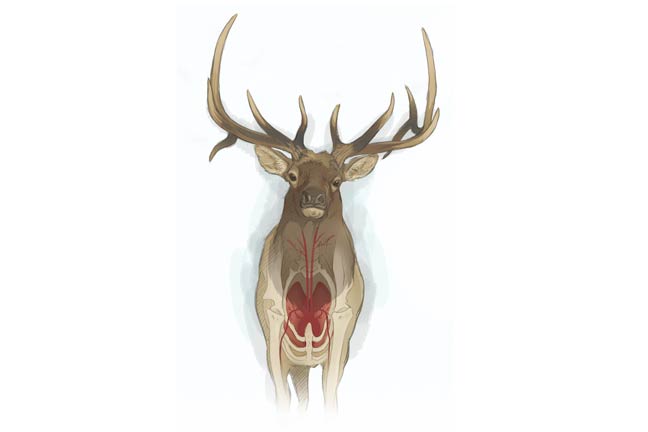
“Shoot him in the spot,” Joe whispered over my shoulder.
Nearly all of my pins covered the sweet spot and the bottom of the “V” of the dark brown hair. I pulled the trigger and watched my arrow disappear. The bull went about 30 yards and stopped. Within seconds, he was done. I couldn’t believe it!
Since I was filming, I took the camera from Joe and wanted to film him blowing a few cow calls the same way he did before the shot. Joe called a few times, and to our amazement a bull reported back.
We looked across the far meadow and a 320-class bull was on a dead run at us, bugling while he was loping. Joe looked at me and said, “I’m going to use my tag on this bull!” He loaded an arrow and we waited for the bull to come charging in, bugling, gurgling and glunking the whole way.
This bull followed the same path as my bull, and at 30 yards he nearly stepped on my bull’s carcass. Joe chirped the cow call one more time and the bull looked up and came right to us. Joe was already at full draw and took the exact same shot as mine just before the bull got to us. His bull whirled around and fell dead within 20 yards of mine. It was one of the craziest memories I have as an elk hunter, and we packed out of that public land on Cloud 9!
Since that day, I haven’t taken that shot again on an elk. But I continue to say that if the shot is very close and the chest is level to the arrow, it is absolutely devastating. In fact, our bulls died much faster than those on any lung shot I have made. The secret spot is right at the bottom of the thick, dark hair on a bull’s neck where it comes to the point with the lighter hair.
Despite its effectiveness, there is much debate over this shot, and if the range is further than 10-15 yards, then the effectiveness and ethics rapidly go downhill. But if you are a thick timber elk hunter and don’t have the luxury of having another caller positioned well behind you to draw the bull past you for a broadside shot, you may want to dig deeper on this subject.












14428 Comments
Leave Comment
Cancel Reply